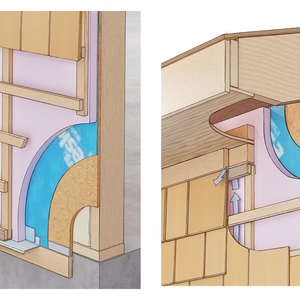Hi folks,
Our 1950’s 2BR rambler was the recipient of a quick and dirty renovation before we moved in (many years ago). The previous owner painted all the walls and trim with latex, covering the oil-painted wood trim with latex w/o primer. We soon discovered the latex paint would peel away from the oil paint at the slightest provocation. Over the years I replaced a lot of it, peeled even more, striped it down to the bare wood in some places, and despite all this experience, I still don’t know a decent way to take the latex off without damaging the oil paint underneath. I’m back at it this weekend.
The folks on this forum seem to have great answers for most situations, so I thought I’d ask you gents.
Has anyone found anything that will take latex off oil paint? It peels away from the flat areas pretty well, but getting off the contoured door and window casings is pretty tough. Most recently, I tried steam and water, but that softens the oil paint as well.
Many thanks for any advice anyone can offer,
Jasper57



















Replies
"Goof Off" and mucho ventilation...
rubs right off.
I HATE that I know the answer to this.
A La Carte Government funding... the real democracy.
Edited 11/14/2008 6:18 pm by Hackinatit
Thanks, Hackinatit, that works. It stinks, but it works.
I have a whole room to do, so if anybody knows any other ways that don't require this much aromatherapy, I'd appreciate it.
Jasper57
I've used an auto body method, to wet sand latex paint out of contours. You'll need a flexible rubber sanding block, and some medium grit wet sandpaper, say 100#, both available at any automotive paint store.
You could also use a more commonly available flexible sanding block, the sandpaper covered sponge type. In either case, wet sanding helps a lot. Keeps the sandpaper from clogging with paint. Remember to protect the floor under the trim with something absorbent, like a towel.
Edited 11/15/2008 12:53 pm by Hudson Valley Carpenter
All of these suggestions will work -the question is, how well? Because of the possible variables (paints involved, age, thickness, etc.) I would try all reasonable ideas before committing to one.
A heat gun is my idea. Unlike oil, latex paint is "thermoplastic", which means it will soften much quicker than the underlying paint. It sounds like there was little or no prep between coats so it's possible that if you hit it just right it will peel/roll right off in big pieces. Too much heat will bubble both paints, though, so be careful.
Another thing that "might" work (or at least help with the residue) is TSP. If you buy the powder kind -not pre mixed- and make a super strong solution with very hot water it will loosen stubborn spots in a few minutes (you would need to protect your floors though).
Once you've removed all the latex and spot primed the bare wood, give the oil paint a quick once over with a "medium" sanding sponge to avoid repeating the problem.
Sanding to promote adhesion will work very well.
Another method is to use what is commonly referred to as liquid sandpaper or deglosser solution.
I have tried a heat gun (softens the oil paint underneath too much) and many other techniques over the years. Nothing really seems to work consistently.
Honestly, I was hoping someone here had a magic bullet for this, like a latex-eating bacteria or a scraper that duplicates the human fingernail (which is the most effective tool I've found so far). Much of the paint will peel off easily, but moldings and curved surfaces are pretty tough for some reason.
I'm going to try putting another coat of latex on a section of the molding to see if the moisture from the fresh paint might soften the coat underneath, then allow both layers to be peeled. This is about the only trick I haven't tried. Thanks for your suggestions, though.
Film at 11,
Jasper57
Paint it with Elmers white glue, when dry, use a credit card ( old, dead one) as a scraper. Cut it to conform to the profile. Scrap carefully, the glue will stay stuck to the paint and reinforce it enough to peel away in larger hunks.Spheramid Enterprises Architectural Woodworks
Repairs, Remodeling, Restorations
They kill Prophets, for Profits.
Wow! Now there's the "magic bullet" answer. The alkyd coat will still need sanding afterwards but that's an excellent trick. No odors or toxic chemicals, just good old Elmer's.
It MIGHT even WORK!!! LOL
( I've done similar in the past with WB Poly on a bad finish, the WB Poly consolidated the old fin, and it all peeled off like one skin..pretty cool actually)Spheramid Enterprises Architectural Woodworks
Repairs, Remodeling, Restorations
They kill Prophets, for Profits.
"It MIGHT even WORK!!! LOL
( I've done similar in the past with WB Poly on a bad finish, the WB Poly consolidated the old fin, and it all peeled off like one skin..pretty cool actually)
Sphere"
Well, Sphere, since nothing else is working, I appreciate you totally pulling this out of your a**. ;-)
The latex overcoat didn't do much, so I will get some Elmer's and give it a shot. (All I have is Titebond.)
I was out at the old house today and I found a set of my father's shave hooks (Made in England!) that really work in the contours though they tend to take the oil paint as well as the latex. It's a shame to use them on this kind of work, though.
Jasper57
Go head and try the TB in an area,,what the hey,Spheramid Enterprises Architectural Woodworks
Repairs, Remodeling, Restorations
They kill Prophets, for Profits.
Heat gun,and power sander.
larry b
Goof-off; crud cutter; and other cleaning stuff in the paint aisle at your big box
"Ask not what the world needs. Ask what makes you come alive... then go do it. Because what the world needs is people who have come alive."
Howard Thurman
I'm dealing with the same problem right now. I've been using a razor and the stuff has been coming off in sheets.
Mine is so loose that even the trim seams arent a problem.
Family.....They're always there when they need you.
You, sir, are a lucky man.
If wood was just a little cheaper (or my time was a little more valuable), I would just pull the old trim and put up new trim all over the house. Wherever I've done that, it looks so much better. I've even tried to pull the old trim, chem strip it, and put it back up but the end result was not really worth it.
Jasper57
If that paint is from the 50's, have you checked it for lead? You may be creating a serious problem stripping it.
Thanks for your concern. The latex paint I'm trying to remove is from the late 80's when the house was renovated (if you call painting DW, wallpaper, trim, and everything in sight with latex and texture paint a renovation).
Still, it's home.
Jasper57